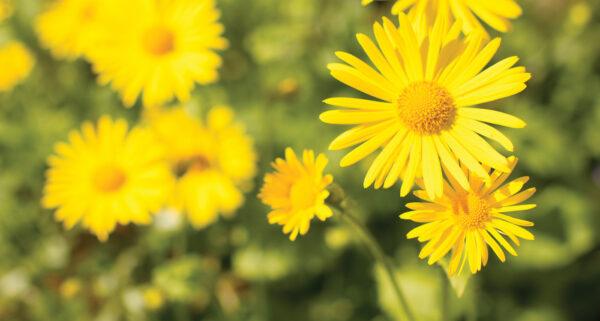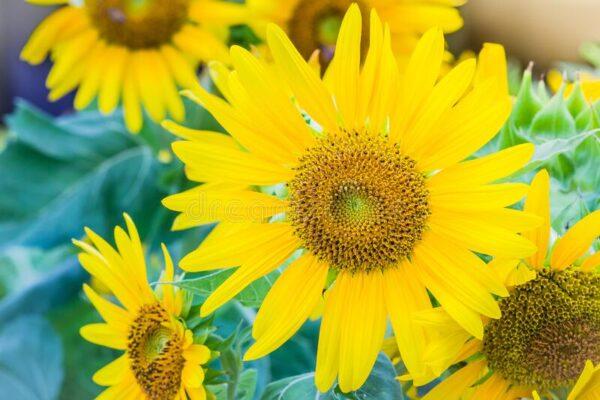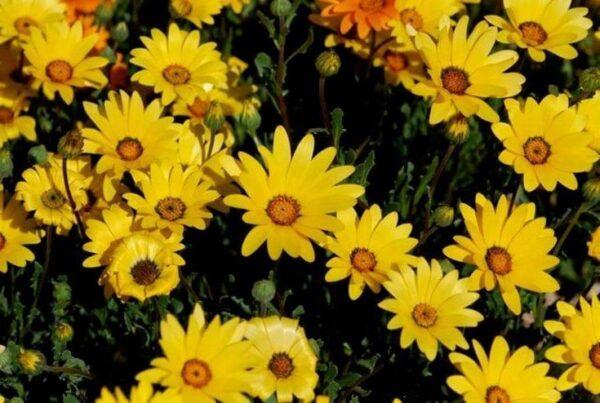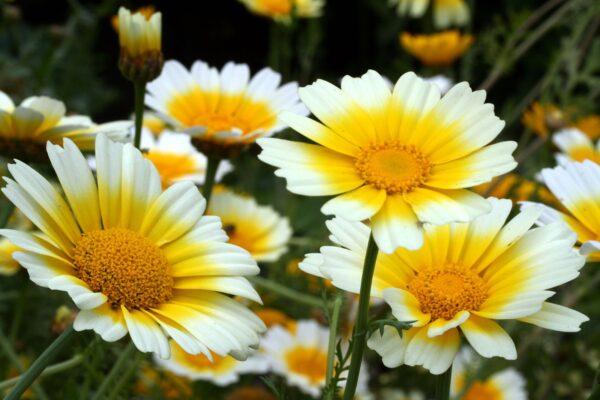Annual Daisy Like Yellow Flowered Plants: Many people are startled by the sheer number of daisy-like Blooms available for purchase in the seed area of the local nursery. Daisies come in so many varieties! As a matter of fact, you may have been out and about in your area and stumbled onto a new variety of flowering plants. While learning about new plants can be scary, it can also be a lot of fun.

What is a Daisy?
There are tens of thousands of daisy-like plants that may be found in gardens, and hopefully, this guide will help you find some of them. If you’re unfamiliar with botany, the term “daisy” can be a little tricky. The Asteraceae family, which includes daisies, is referred to as the “daisy family” by certain florists. The Asteraceae family is the second-largest plant family in the world, therefore this might be an issue. More than 20,000 species and 1,500 genera make up this phylum. Erigeron genus plants, on the other hand, are occasionally referred to as daisies by botanists. Asteraceae is a large family, yet this is just one genus.
In any case, daisies are unquestionably members of the Asteraceae family of plants. It doesn’t matter how you slice it, there are tens of thousands of daisies in the globe. When it comes to flowering plants, the Asteraceae family has both ray flowers, which are yellow, and disc flowers, which are brown. Ray flowers are commonly referred to as “petals” by the general public. Flowers of this family used to be referred to as Compositae because of the way they are composed of many different little, ray, and disc flowers. Erigeron is the first genus on the list, however, the Asteraceae family includes several additional genera that resemble the common daisy in our minds.
What Is the Origin of Daisies?
Daisies can be found all over the world, from the arctic to the tropics to Australia’s subtropics. In the Asteraceae family, the origins are unknown. About 100 million years ago, when continents were considerably closer together than they are now, plants began to appear. Annual or perennial, daisies can be herbaceous or woody. The Asteraceae family includes some trees, but most people don’t think of them as daisies. Pollinators of 100 million years ago found Asteraceae to be a rich source of pollen and attractive flowers during a time when wildflowers were less diversified and possibly less nourishing.

Through pollination and seed dissemination, these attractive resources enticed a variety of pollinators and herbivores to unwittingly help disperse the flowers throughout the planet. There are several ways in which you can think of daisies today. Despite the fact that these ecosystems tend to be the most diversified, I challenge you to identify a place where the Asteraceae family does not have a presence! They’re all over the place! There are more than 32,000 recognized species of flowering plants in the Asteraceae, or Compositae,[5] family, which includes more than 1,900 genera in the Asterales order.
Aster, daisy, composite, and sunflower are all terms used to characterize the Compositae group of plants, which was originally published in a scientific journal in the year 1740. Only the Orchidaceae have more species than the Asteraceae, and it’s uncertain whether the family has the largest number of extant species. Plants that belong to the Asteraceae family are primarily herbaceous but include shrubs and trees. There is a vast range of habitats in which the family can be found, from sub-arctic to tropical climates. They can be found on every continent except Antarctica, with the exception of Antarctica.
Annual Daisy Like Yellow Flowered Plants
Flower heads, or more precisely, capitula, typically include hundreds of small individual florets that are bound together by a protective involucre. Pollen grains from Antarctica’s Late Cretaceous period, which date back 76–66 million years, are the oldest fossils (myr). With a stem node age of 88–89 million years ago (Late Cretaceous, Santonian), the crown group of Asteraceae is thought to have evolved at least 85,9 million years ago. The family Asteraceae provides food staples, garden plants, and herbal medicines, making it an economically significant one.

Weeds and invasive species can exist outside of their natural habitats. Species with composite flowers, which appear to be a single flower but are actually made up of several separate flowers aligned in a radiating pattern, can be identified. The most common hues are white, yellow, and purple, but horticulturists have developed a wide variety of cultivars with a wide range of hues and bloom forms. Almost all of these plants are also well-known for their ability to thrive in relatively dry environments, making them ideal for places where other flowers might struggle.
Daisies conjure up images of the small white flowers with vivid yellow centers that we used to pick while humming “He loves me, he loves me not” in middle school when we hear the term. In spite of the fact that the common daisy has become an invasive weed in the United States due to its quick spread, daisies exist in tens of thousands of distinct variants beyond the iconic white blooms that we are all familiar with. Varieties like full-faced gerbera daisies and African daisies with vibrant colors and chrysanthemum daisies that look like fluffy pom-poms are among the most popular nowadays.
Great options if you want daisy-like flowers
- Flowers of the Gerbera Daisy variety (Gerbera jamesonii): An annual plant native to South America, Africa, and Asia, the gerbera daisy (also known as the Transvaal daisy) is a clump-forming perennial species.
- Tea made from German chamomile (Matricaria chamomilla): The German chamomile (Matricaria recutita), with its tiny white daisy-like blossoms on wiry stems, goes by the common name “chamomile.”

Daisies thrive in full sun and are rarely affected by insects or disease, making them one of the best full-sun flowers. As you begin to plan your garden for spring and summer, take a look at these top English garden ideas for ideas on how to include daisies into your landscape. You can’t go wrong with daisies in your garden, no matter which variety you plant. One of the most low-maintenance flowers is the daisy, which requires only sunlight and well-draining soil to thrive.
Fake Sunflower (Heliopsis helianthoides): Oxeye sunflowers, also known as tall plants with full yellow-orange flowers, thrive in warm southern regions and are a suitable choice for soils with little nutrients.
Marigolds in a pot (Calendula officinalis): It’s an excellent companion plant since calendula attracts beneficial insects that eat pests and is delicious, therapeutic, and aids in natural pest management.
Thistle (Aster spp.): Aster is a genus with 180 species, however, the most often used cultivars are the result of crossbreeding.
Daisies from Africa (Osteospermum x hybrida)
There are many varieties of hybrids based on O. echelons, O. jucundum, and other species sold as African daisies or osteospermum. Adding daisies to your garden this spring may be an excellent idea. Daisies are among the easiest flowers to grow, so you’re in luck. To plant daisies in your garden, you’ll need to buy seeds. There are a number of daisies that bloom at different times of the year; depending on your preference, daisies can be some of the greatest early spring flowers or the best summer flowers to include in your garden.




